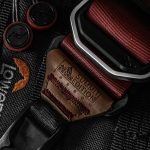You’ll find white Kevlar fabric delivers exceptional strength and durability without sacrificing style. Its lightweight, heat-resistant fibers protect you from cuts, abrasions, and impacts while offering a clean, bright look that fits modern designs. Whether you’re using it for protective gear or fashion, it combines safety with sleek aesthetics. Plus, it’s easy to care for and eco-friendly, making it a smart choice—explore further to see how it transforms both function and fashion.
Table of Contents
Key Takeaways
- White Kevlar fabric combines high tensile strength with a bright, neutral color for stylish yet durable applications.
- It offers exceptional cut, abrasion, and impact resistance, making it ideal for protective clothing and safety gear.
- The material’s lightweight and thermal stability ensure comfort and durability in various environmental conditions.
- Its clean aesthetics and ability to be dyed or printed support innovative fashion and protective design options.
- Eco-friendly features include recyclable fibers and sustainable production, aligning strength with environmental responsibility.
Properties and Benefits of White Kevlar Fabric
White Kevlar fabric combines exceptional strength with a clean, versatile appearance. When you use it, you benefit from its high tensile strength that resists cuts, abrasions, and impacts.
You’ll appreciate how lightweight it is, making it comfortable for extended wear or applications where weight matters. Its thermal stability means it withstands heat without degrading, so you don’t have to worry about damage from extreme temperatures.
Plus, the white color offers a bright, neutral look that integrates seamlessly into various designs without compromising durability. You’ll also find it resistant to chemicals and moisture, which extends its lifespan.
Applications in Personal Protective Equipment
When you wear personal protective equipment made from white Kevlar fabric, you get excellent impact resistance that keeps you safe in tough situations.
You’ll also appreciate how lightweight it feels, so you stay comfortable without sacrificing protection.
Let’s explore how these features make white Kevlar ideal for gear like helmets, vests, and gloves.
Impact Resistance Benefits
Because you rely on personal protective equipment to keep you safe, choosing materials with superior impact resistance is essential.
White Kevlar fabric offers exceptional protection by efficiently absorbing and dispersing energy from impacts. When you wear gear made from this fabric, it markedly reduces injury risks from blunt force or shrapnel.
Its tightly woven fibers create a strong barrier that doesn’t easily puncture or tear, giving you reliable defense in hazardous environments. Additionally, white Kevlar maintains its integrity even after repeated impacts, so you can trust your equipment over time.
Lightweight Comfort Features
Although protective gear must be tough, you don’t have to sacrifice comfort to stay safe. White Kevlar fabric offers lightweight comfort, making it ideal for personal protective equipment (PPE). Its low weight reduces fatigue, while breathability keeps you cool during long wear.
Here’s how white Kevlar enhances comfort in PPE:
| Feature | Benefit | Application |
|---|---|---|
| Lightweight | Less fatigue | Tactical vests, gloves |
| Breathable | Moisture control | Helmets, jackets |
| Flexible | Improved mobility | Armored suits, knee pads |
White Kevlar in Fashion and Design
As you explore innovative materials for your designs, white Kevlar stands out for its unique blend of strength and style. You can integrate it into fashion pieces that demand durability without sacrificing aesthetic appeal.
White Kevlar’s clean, bright appearance lets you create sleek, modern looks that resist wear and tear. Whether you’re designing protective outerwear, accessories, or avant-garde apparel, this fabric adds a futuristic edge.
It also pairs well with various textiles, giving you flexibility in texture and function. Plus, white Kevlar reflects heat better, enhancing comfort in warmer conditions.
Comparison With Traditional Kevlar Colors
When you compare white Kevlar to traditional yellow or gold Kevlar, you’ll notice several key differences that affect both appearance and performance.
White Kevlar offers a clean, modern look that blends easily with various fabrics and styles, making it ideal for fashion-forward applications. In contrast, the classic yellow Kevlar is instantly recognizable and often associated with industrial or tactical use.
Performance-wise, both colors maintain similar strength and durability since the color doesn’t impact Kevlar’s inherent protective qualities. However, white Kevlar may show stains or discoloration more readily, which could influence your choice depending on the environment.
Ultimately, your decision between white and traditional Kevlar colors depends on your priorities for visual appeal and practical use without sacrificing protection.
Maintenance and Care for White Kevlar Fabric
Caring for white Kevlar fabric requires a bit more attention than its traditional counterparts because its light color shows dirt and stains easily.
You’ll want to spot clean stains immediately using a mild detergent and cold water to prevent discoloration. Avoid bleach or harsh chemicals, as they can weaken the fibers and yellow the fabric.
Spot clean stains quickly with mild detergent and cold water; avoid bleach to protect and preserve white Kevlar.
When washing, use a gentle cycle and cold water to maintain the fabric’s strength and brightness. Air drying is best—steer clear of high heat from dryers, which can damage the material.
Store your white Kevlar in a cool, dry place away from direct sunlight to prevent fading.
With proper care, you’ll keep your white Kevlar fabric looking sharp while preserving its protective qualities.
Innovations and Future Trends in Kevlar Materials
You’ll see exciting advances in Kevlar materials, like advanced weaving techniques that boost strength and flexibility.
Sustainable alternatives are also emerging, aiming to reduce environmental impact without sacrificing performance.
Let’s explore how these innovations could shape the future of white Kevlar fabric.
Advanced Kevlar Weaving
Innovations in advanced Kevlar weaving have transformed how this remarkable fabric performs in demanding environments.
You’ll find that modern weaving techniques enhance Kevlar’s strength and flexibility, making it lighter without sacrificing durability. By manipulating fiber orientation and density, manufacturers tailor the fabric to specific uses—from body armor to aerospace components.
You can also notice improved abrasion resistance and better impact absorption, thanks to tighter, more precise weaves.
Plus, advanced weaving allows for more consistent quality and customized designs, including the striking white Kevlar fabric that blends safety with style.
As you explore Kevlar’s potential, these weaving breakthroughs open new doors for performance and aesthetics, ensuring this fabric meets tomorrow’s challenges head-on while maintaining its signature toughness.
Sustainable Kevlar Alternatives
As advanced weaving techniques push Kevlar’s capabilities further, the industry also faces growing pressure to develop more sustainable options.
You’ll find that researchers are exploring bio-based fibers and recycled materials to reduce environmental impact without sacrificing strength. Innovations like bio-Kevlar made from renewable resources offer promising alternatives, blending durability with eco-friendliness.
Additionally, recycling Kevlar waste into new fabric minimizes landfill contributions and conserves resources. Future trends point toward integrating these sustainable fibers into existing production lines, making it easier for you to choose responsible materials.
Environmental Impact and Sustainability Considerations
Although White Kevlar fabric offers remarkable strength and durability, its environmental impact deserves careful attention. When you choose this material, you should understand the energy-intensive production process and challenges in recycling it.
Kevlar’s synthetic nature means it relies on non-renewable resources, which can contribute to pollution and waste. However, innovations are emerging to reduce its footprint and improve sustainability.
Here’s what you need to evaluate:
- High energy consumption during manufacturing
- Limited biodegradability and recycling options
- Potential release of harmful chemicals if improperly disposed
- Advances in recycling technologies and material reuse
- Growing interest in bio-based and eco-friendly fibers
Frequently Asked Questions
Can White Kevlar Fabric Be Dyed Other Colors Without Losing Strength?
You can dye white Kevlar fabric other colors, but you’ll need special processes to avoid weakening it. Regular dyes might affect its strength, so make sure to use methods designed specifically for high-performance fibers like Kevlar.
Is White Kevlar Fabric More Expensive Than Standard Yellow Kevlar?
Think of white Kevlar as the pearl among oysters—it’s often pricier than standard yellow Kevlar because of specialized production and bleaching processes. You’ll pay extra for that distinct look, but strength usually stays intact.
How Does White Kevlar Fabric Perform in Extreme Weather Conditions?
You’ll find white Kevlar fabric performs well in extreme weather, resisting heat, cold, and moisture just like standard Kevlar. It maintains strength and durability, so you won’t have to worry about protection or wear in harsh conditions.
Are There Any Health Risks Associated With Handling White Kevlar Fabric?
Did you know 1 in 10 workers handling Kevlar report skin irritation? You might experience mild itching or rash if fibers get on your skin. Always wear gloves to protect yourself and avoid inhaling dust particles.
Can White Kevlar Fabric Be Recycled After Use?
You can recycle white Kevlar fabric, but it’s not widely accepted in regular recycling programs. Specialized facilities handle it, so you’ll need to find a recycler experienced with aramid fibers to guarantee proper processing.
- Jaclyn Smith Fabric Coconut: a Review of This Rayon/Polyester Blend - June 29, 2025
- Jaclyn Smith Fabric Coconut: a Review of This Rayon/Polyester Blend - June 29, 2025
- How to Get Coconut Oil off Fabric Without Washing - June 29, 2025







